
© Nikita Chuntomov. (Click image for larger version)
Ekaterina Maximova Arabesque Ballet Competition Gala
Opening Gala in Honour of Marius Petipa and Lev Tolstoy
Perm, Perm Opera and Ballet Theatre
11 April 2018
www.arabesque.permonline.ru
permopera.ru
This proved an opening concert with an interesting and well thought out programme. The occasion was the 15th anniversary of the Ekaterina Maximova Arabesque Ballet Competition named, since 2012, after the late and much-loved Bolshoi ballerina, and organised by her husband, Vladimir Vasiliev. As charming as ever and receiving rapturous applause from the Perm Opera and Ballet Theatre audience when he came on stage to introduce the evening’s programme, Vasiliev stated that the gala would honour two of Russia’s greatest artistic and literary geniuses. The first half was to celebrate the 200th anniversary of the birth of Marius Petipa, while the second would be in homage to Lev Tolstoy who was born in 1828. For this, Vasiliev had commissioned six contemporary works from six young Russian choreographers, based on Tolstoy’s writings.
The evening began with well-loved classical extracts which have been handed down through the years and which show off Petipa’s exceptional creative ability. They were danced by former prize winners of the Arabesque competition who showed clearly in their performances why they had won – musicality, technique, expressiveness and grace, all ribboned together with excitement.
The first piece – The Dance of the Hours from La Giaconda – however was danced by possible future Arabesque contestants: young students from the highly respected Perm State Choreographic School, a few minutes walk away from the theatre. It was a colourful piece with pink, turquoise and purple tutus and the young girls evidenced the finesse and beauty of Petipa’s work. Well drilled, they showed great joy in their dancing. The unnamed soloist, in black tutu and her partner in blue shiny pants showed great style and technique, and all-in-all, it was a charming way to start the evening.
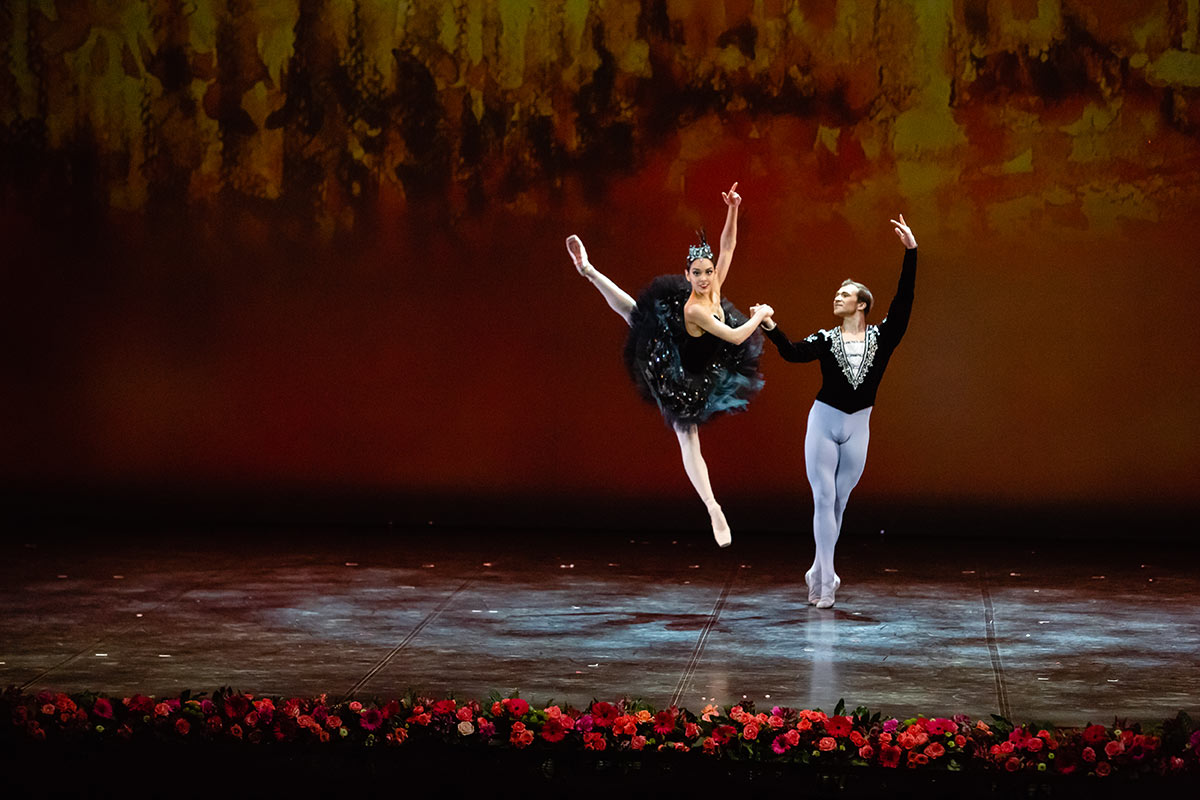
© Edvard Tihonov. (Click image for larger version)
The Black Swan pas de deux was performed by Brazilian Amanda Gomes (Arabesque 2014) who, moving with alacrity, flashed her eyes and spliced off 32 phenomenal fouettes as she seduced her hapless bewitched prince, nicely performed by Mikhail Timaev (2008).
The male solo God of the Wind from Talisman is always a showy piece and Ernest Latypov (2014 and now at the Mikhailovsky Ballet in St Petersburg) performed with gusto, giving it all his might and strength. He returned later to dance the male Don Quixote solo with dignity and crisp, clean technique.
Two diminutive Japanese dancers, Terada Midori and Okava Koya, winners in 2012 and now at the Tatarsky Ballet performed the grand pas from The Sleeping Beauty with spot-on accuracy and delicacy – she like a china doll showing all her movements with clarity and fine line while he made accurate jumps and had sharp attack.

© Nikita Chuntomov. (Click image for larger version)
Two Perm Opera and Ballet dancers showed off the precision and clean technique of their training in a beautifully presented pas de deux from La Bayadere’s Kingdom of the Shades. Nikita Chetverikov (2014) bounded across the stage with the lightest of leaps, skimming the surface like a flat stone on a pond, while Inna Bilash, in an old style flatter off-white tutu exhibited grace in her ‘floating’ ability and strong control in her slow developés.
But the cherry on the top of these excellent performances was the appearance of the South Korean, now Mariinsky Ballet principal, Kimin Kim (he won Arabesque’s Grand Prix in 2012). He danced in the flashy Diana and Acteon pas de deux with Renata Shakirova. Kim has developed from a superb technical dancer into a highly dramatic technical artist as this relatively short work showed. His facial expressions and body actions told the story of his role, and my! what he could do with his body. Not only did he offer great height in his leaps, but he added yet more new tricks. He holds a presence on stage today for his audiences that is reminiscent of Vladimir Vasiliev in his early days. Kim’s bold and showy dancing brought the curtain down on the first act with thunderous applause.

© Nikita Chuntomov. (Click image for larger version)
After a short break, Vasiliev returned to the stage to pay homage to Tolstoy, to his life and his vast collection of works. In an impassioned speech that bordered on the edge of an actor’s delivery, he summarised the great writer’s life and philosophy and his opinions on love, temptation and death, the horrors of war and his philosophical views on God and subsequent battles with church officialdom. Admirably, Vasiliev asked six young Russian choreographers to choose one of Tolstoy’s stories and create a short ballet – 15 minutes maximum.
Most of the stories were unknown to me – one would need a degree in Russian literature to know all the ins and outs of the chosen works. Also, with the lack of consistent wi-fi connections in my Perm hotel my hopes to do a cram Google course didn’t go to plan, and so my remarks about the ballets are visual observations rather than a deep understanding of what Tolstoy was aiming at. Fortunately for me, the works, while not showing anything astounding choreographically, were all descriptive enough to make them generally comprehensible and fascinating.
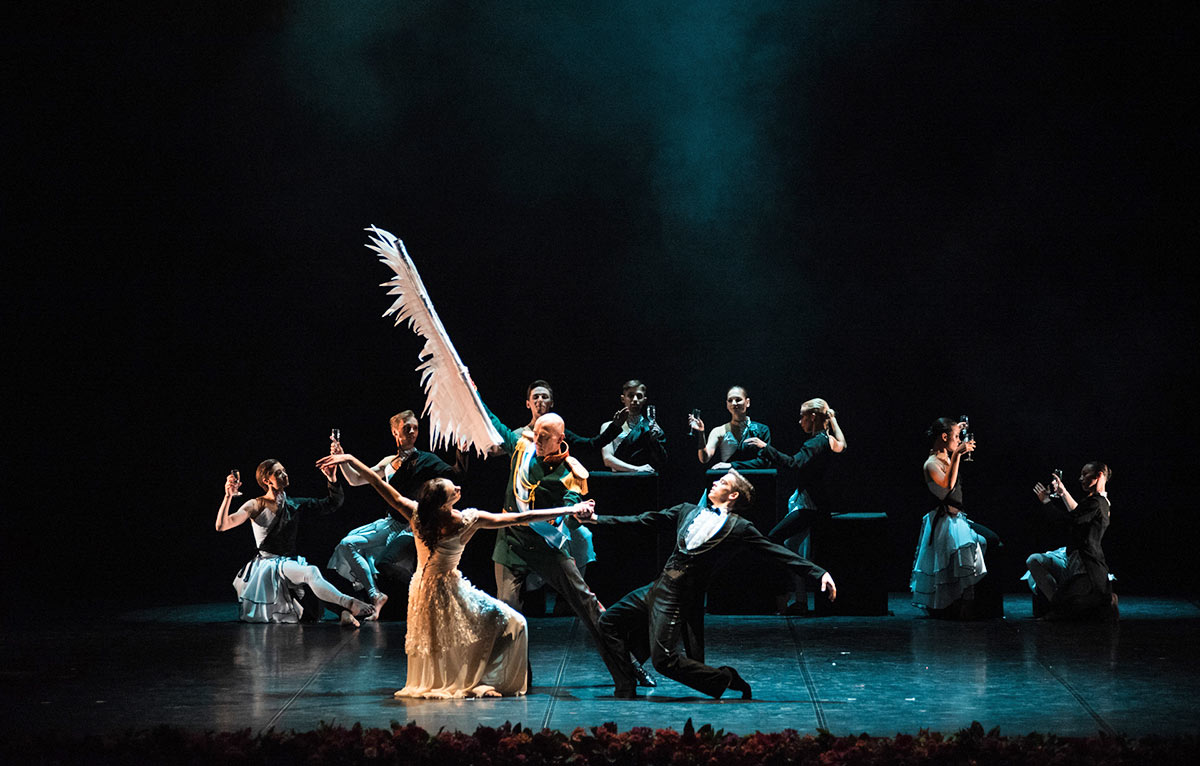
© Nikita Chuntomov. (Click image for larger version)
The first was by 40-year-old Alexei Rastorgyev from Perm. He chose Posli Bala (After the Ball), a short work about a young man in love with the beautiful daughter of a colonel. Later he encounters the father – in the name of military authorisation – brutally flogging a Tartar deserter. This cruelty to another human being causes the young man to turn away from his life’s desires. For his set, Rastorgyev used different sized moveable blocks which were constantly rearranged; at one point they became stairs to a pedestal onto which Ivan Vasilievich lifts his beloved Varya in their first love duet. The guests at the ball are androgynous in costume – half a white flouncy ballgown, the other side a tailcoat – and there is an acrobat who cartwheels on and off. The Colonel has a crutch made from a large swan’s wing which is white at the ball, then it is replaced at the end by a black one – referencing Von Rothbart? The choreography was graphic enough to show the basic plot and, with Tchaikovsky’s music, made a satisfying opening to the second half.
Pavel Gluxhov (32), who comes from Moscow, created the next piece entitled Moloch. In the 19th century, “Moloch” came to be used allegorically for any idol or cause requiring excessive sacrifice, and the scenario of this ballet is based on pacifist Tolstoy’s Sevastapol Sketches which depicts, in novel form, his own witnessing of the devastating Crimean War (1853-6) against the French and British. Performed to music by Arvo Pärt, the work was very descriptive of the futility and cruelty of war.
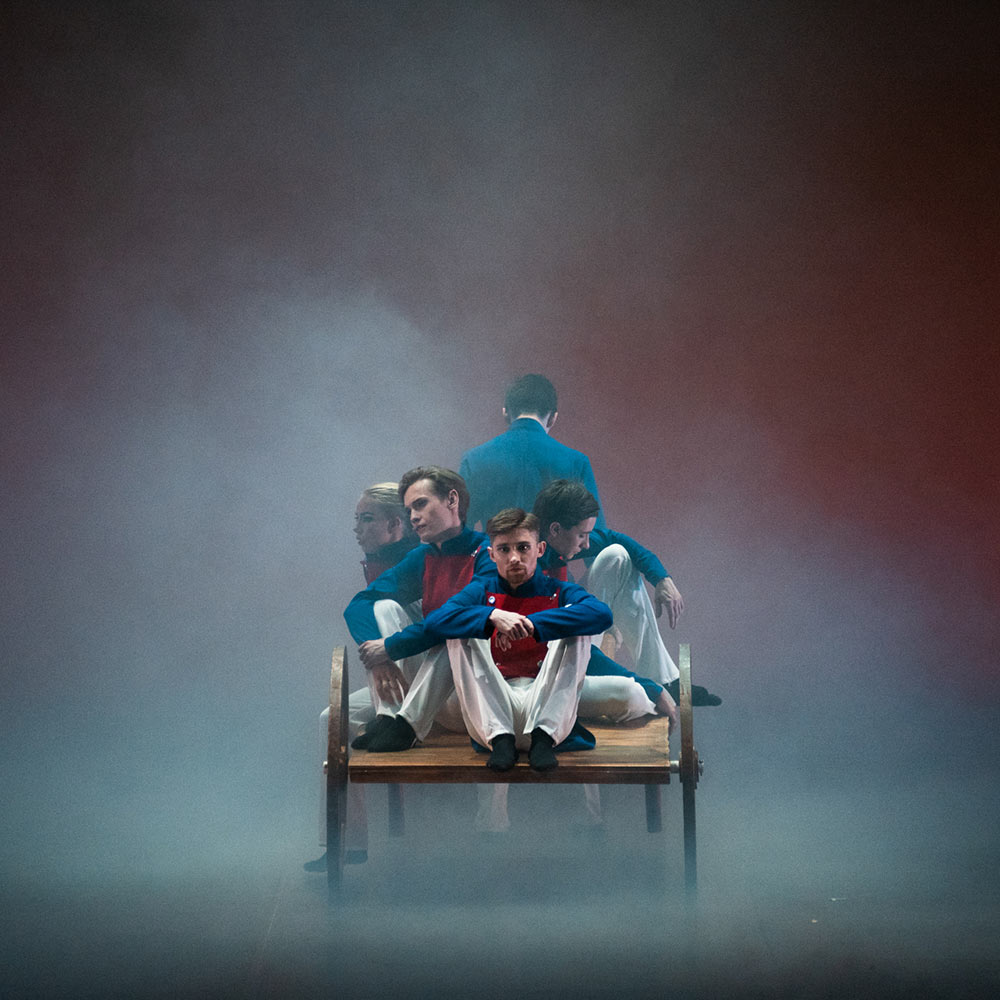
© Nikita Chuntomov. (Click image for larger version)
A squeaky, creaking old wagon is pulled up a slope through thick smoke at dusk, and later it becomes apparent that it is piled high with dead soldiers. In a flashback, we watch the young Russian lads in their white trousers, blue jackets with red bibs in scenes of musket loading and firing, fallen soldiers, stretchers and nurses – but their battle against the enemy is all in vain. A white flag of surrender is waved but still the slaughter continues until the cart is again seen trundling up the path as in the beginning, but now beneath a blood red smoky sky. It was a poignant and thought-provoking piece which the choreography depicted well.
The Kreutzer Sonata is one of Tolstoy’s better-known stories and has been seen on London stages and in films. It is a tale that was banned due to its considered immoral attitudes concerning marriage and adultery. Condensing the story into just a few minutes, 29 year old Dmitry Antipov, who comes from Voronezh, and today works as teacher and choreographer at the London Russian Ballet School, uses Leoš Janáček’s First String Quartet to accompany the twisted world of raging jealousy and suspicion in his Rokovaya (Fatal) Sonata. There is smoke and spoken words at the start, and one watches the unravelings of Pozdnyshev’s initially happily married state turning into all-consumimg suspicion about the infidelity of his pianist wife for a violinist when they play Beethoven’s Kreutzer Sonata together. Some actions took place behind lit screens, as though evidencing Pozdnyshev’s inner turmoil, and finally his raging jealousy results in the murder of his wife. Strong dancing again from members of Evgeny Panfilov Ballet Theatre.

© Nikita Chuntomov. (Click image for larger version)
Diyavol (Devil) deals with sexual emotion and its consequences and was created by Yulia Bacheva (32, from Perm) who brought colour and drama to the stage in the tale of sexual frustration and devilry – red costumed athletic dancers who leapt and twirled in frenzied primeval action. The hero of the tale is torn between lust and loyalty to his wife and finally solves his torment by killing himself. Again, an effective and interesting work.
Odnazhdi Zimmoi (One day in winter) is a tale about two men lost in a snowstorm who are followed by a small spritely figure representing the frost that prevents them from finding warmth anywhere. The master, in a sympathetic move since it is he who has brought the peasant into the woods, puts his coat over him. But in saving him, he himself gradually freezes to death. Konstantin Keizhel was the choreographer of this short work and he was well able to convey the emotions of the men who had lost their way.
The final work was Zapiski Sumashedshevo – Crazy Scraps – also to Janáček’s music, and choreographed by Alexander Mogilev (31, from Murmansk). The focus of his ballet is a man who has a library full of books which others try, by many slick means, to destroy. He tries to protect his books but as they are finally sent crashing to the ground, cracks appear on the backdrop developing into a cross shape. A lot of energetic dancing in this one.

© Nikita Chuntomov. (Click image for larger version)
After all six pieces, the dancers returned on stage with Vasiliev to bow in homage to a portrait of Lev Tolstoy which now hung from the backdrop. Vasiliev again commanded the stage with an epilogue in which he stated that we had seen in the six short works, some of the great writer’s views on life – love, passion, sexual abstinence, purity, war and peace etc. But basically, Tolstoy believed that we are all one family and that God wants all people to live together in harmony. Vasiliev concluded with Tolstoy’s words to everyone – ‘Bog yest lyubov’ – God is Love.










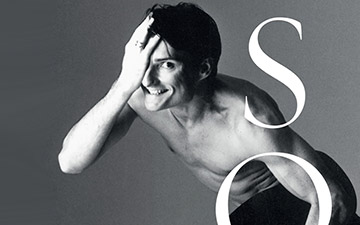



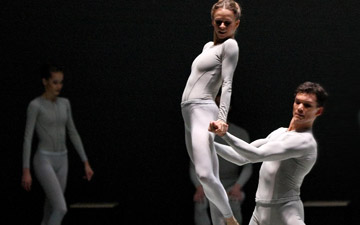
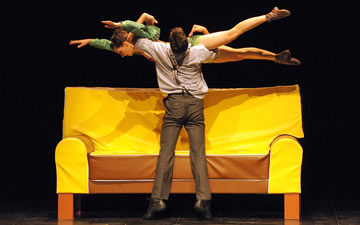

A wonderful review and of course to be expected from Margaret Willis.
What are the chances of her reporting on the winners of the Arabesque competition?
I’ve heard that someone from tje Berlin Ballet Academy won silver.